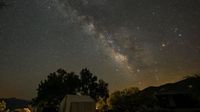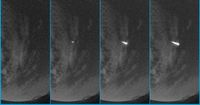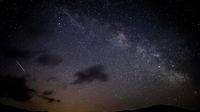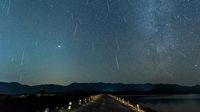After months without a meteor shower, sky watchers have a reason to be excited: the Lyrids are here to kick off the season. The Lyrids have been gracing the sky since April 17 and will remain visible until Saturday, April 26, 2025. The peak concentration of meteors is expected between the night of Monday, April 21, and the early morning of Tuesday, April 22, according to the American Meteor Society.
In a perfectly dark sky, observers can typically see up to 18 meteors per hour during the peak of the Lyrid shower. However, this year, the light from the waning crescent moon will make it challenging to observe the celestial spectacle. Still, attentive observers in the Northern Hemisphere can expect to see around five intermittent lights per hour between 10 p.m. local time on Monday and 4:30 a.m. on Tuesday, said Dr. Bill Cooke, director of NASA's Meteoroid Environment Office.
“Most of the meteors seen during a Lyrid shower aren’t bright fireballs but rather faint streaks, and the more moonlight there is, the more they wash out,” Cooke explained. “Meteor watching is one of those activities where you have to take your time.” For an optimal visual experience, Cooke recommends lying down outdoors in an area with minimal light pollution and allowing your eyes about 30 minutes to adjust to the darkness. “Another important thing is: Don’t look at your phone, because that bright screen prevents you from seeing the night and distracts you from the sky,” he added.
More about the Lyrids: Meteor showers occur regularly throughout the year as Earth passes through a field of debris left by comets and asteroids, said Shannon Schmoll, director of the Abrams Planetarium at Michigan State University. The Lyrids originate from the comet C/1861 G1 (Thatcher), which is approximately halfway through its 415-year orbit around the Sun. Although the Thatcher comet was discovered in 1861, the Lyrids have been observed for 2,700 years, making them one of the oldest known meteor showers, according to NASA.
The best time to view the Lyrids is when Lyra, the constellation in the Northern Hemisphere from which the meteors appear to radiate, is above the horizon, according to EarthSky. What happens during a meteor shower? As the comet travels, it leaves a trail of ice and dust that moves at thousands of kilometers per hour, according to astronomer Dean Regas. “The meteors hit the Earth’s atmosphere and slow down, transmitting heat. That’s the flash you see,” Regas said. “Most of the material from meteor showers, the fragments from comets, burns up before hitting the ground, and many are the size of a grain of sand. So it’s really impressive to see something so small light up like that.”
While the Lyrids tend to be relatively predictable each year, they occasionally exceed expectations. Eruptions of 100 meteors per hour occur unpredictably, on average about every 60 years. The next explosion is expected around 2042, according to the American Meteor Society. The cause of these explosions is not exactly known, but it is believed that other planets and objects influence the density of the debris as they cross paths, Schmoll noted.
If you miss the peak of the Lyrid shower, you still have the chance to see some shooting stars this year. Here are the peak dates for upcoming meteor showers in 2025, according to the American Meteor Society and EarthSky:
- Eta Aquarids: May 5 and 6
- Southern Delta Aquarids: July 29 and 30
- Alpha Capricornids: July 29-30
- Perseids: August 12-13
- Draconids: October 8 and 9
- Orionids: October 22 and 23
- Southern Taurids: November 3 and 4
- Northern Taurids: November 8 and 9
- Leonids: November 16 and 17
- Geminids: December 12 and 13
- Ursids: December 21 and 22
As for the remaining full moons in 2025, after the recent pink moon event, there are eight more to look forward to this year, with supermoons occurring in October, November, and December. Here’s the list of remaining full moons in 2025, according to the Farmers’ Almanac:
- May 12: Flower Moon
- June 11: Strawberry Moon
- July 10: Deer Moon
- August 9: Sturgeon Moon
- September 7: Corn Moon
- October 6: Harvest Moon
- November 5: Beaver Moon
- December 4: Cold Moon
Also, two eclipses will adorn the sky before the fall season. A total lunar eclipse will be most visible from Europe, Africa, Asia, Australia, parts of eastern South America, Alaska, and Antarctica on September 7 and 8, 2025. A lunar eclipse, which makes the moon appear dark or dimmed, occurs when Earth is between the sun and the moon, and the three celestial objects align so that the moon passes into our planet's shadow. When the moon is in the darkest part of the Earth’s shadow, called the umbra, it takes on a reddish hue, giving rise to the nickname “blood moon” for lunar eclipses, according to NASA. This shadow isn’t perfect, so sunlight filters through its edges, bathing the moon in warm tones.
A partial solar eclipse will occur on September 21, 2025, when the moon moves between the sun and Earth, but the celestial bodies are not perfectly aligned, according to NASA. In this type of event, the moon only blocks part of the sun’s face, creating a crescent shape that looks as if the moon is taking a bite out of the sun. This event will be visible in parts of Australia, Antarctica, and the Pacific Ocean.






